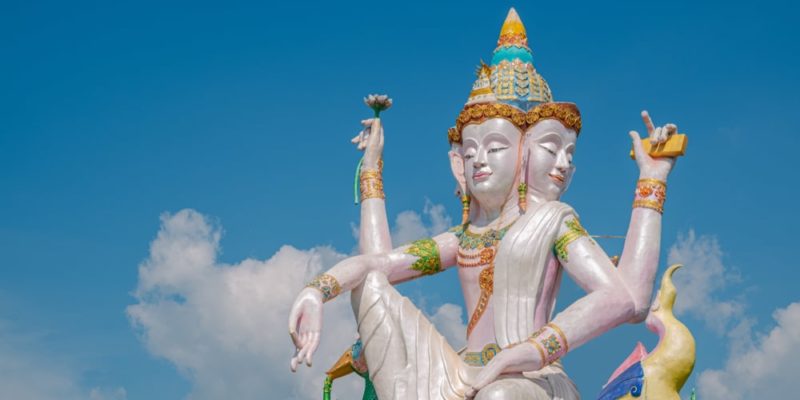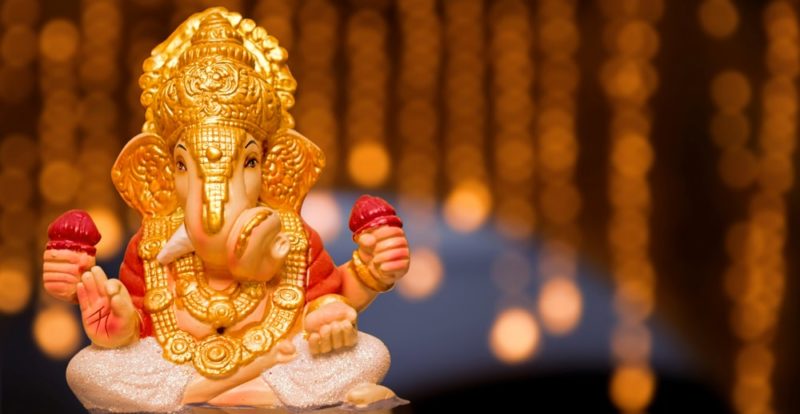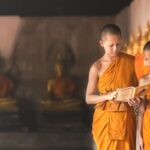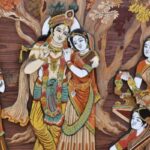We explain what Hinduism is, its origin, main gods and sacred writings. Also, their beliefs and differences with Buddhism.

What is Hinduism?
Hinduism is one of the religions with the most followers in the world. It emerged in the Indian subcontinent from the Vedic religion developed around 1500 BC. C and It is currently one of the most complex and diverse religions. Hinduism lacks a single, structured body of beliefs and practices, contains polytheistic, monotheistic and pantheistic interpretations, and is largely a philosophy of life.
The term “Hinduism” was introduced by British colonists in the first decades of the 19th century. to identify the various religious practices and beliefs of India that did not correspond to other known religions (such as Christianity, Islam and Jainism). It derives from the term “Hindu”, which was used by the Persians to refer to those who lived beyond the Indus River, by the British for the population of Hindustan (Indian subcontinent) and then by Indian nationalists to consolidate their national identity in their struggle. against British colonialism. However, the original practitioners of this religion did not group themselves under a single denomination. Currently, some Hindus accept the word Hinduism for their religion, while others prefer the term sanatana dharma (“eternal law” in Sanskrit).
Hinduism is the majority religion in India, Nepal, Mauritius and the island of Bali (in Indonesia) and has more than one billion followers around the world, many of them in countries such as Bangladesh, Pakistan, Sri Lanka, Malaysia, Myanmar, the United States and the United Kingdom. Besides, many Hindu practices spread to the West throughout the 20th century without its practitioners necessarily adhering to Hinduism, like yoga.
Hinduism is not a uniform religion with a single hierarchical and organized structure, but a diverse set of practices and beliefs that often focus on ideas such as spirituality, dharma (the law that dictates correct behaviors), karma (the energy derived of a person's acts) and samsara (reincarnation). Nor does it have a historical founder or a religious leader among the faithful around the world, nor is there a Hindu church comparable to the Catholic Church.
However, there are Hindu temples (called mandirs), rituals or pilgrimages are carried out and deities are venerated (one or several, depending on the current). Some of the main Hindu deities are Brahma, Shiva, Vishnu (and his avatars Krishna or Rama), Ganesha, Kali and Devi. Some rites or teachings are in charge of priests or spiritual guides and meditation practices and vegetarianism are common (in fact, cows are considered sacred).
For Hinduism, in addition, some ancient epic and mythological stories are sacred, such as the Ramayana and the Mahabharataand various ritual or philosophical texts. However, only the character of eternal revelation is recognized to the Vedas (liturgical texts compiled over the centuries, the oldest compositions of which probably date from 1500 BC).
Practitioners of Hinduism are called Hindus or Hindus, terms that should not be confused with the demonym of India, which is “Indian” (although it is common for “Hindu” to be used in this sense, but this is not recommended by the Royal Spanish Academy).
Thus, there are Indians (natives of India) who practice Hinduism, Islam, Christianity, among other religions. For its part, the majority language of India is not called “Hindu” but “Hindi”.
Key points
- Hinduism is one of the most followed religions in the world, with around 1.1 billion followers.
- It emerged in the Indian subcontinent around 500 BC. C., from the development of a previous religious tradition known as Brahmanism or Vedic religion.
- It is a polytheistic religion, although it also has monotheistic and pantheistic interpretations. Its main gods are Brahma, Shiva and Vishnu.
- It promotes meditation, yoga and vegetarianism, and is based on four concepts: dharma (the law of what is right), samsara (reincarnation), karma (the effect of actions on reincarnation) and moksha (liberation). of the cycle of reincarnations).
- Its sacred books are the Vedas, but it also follows a set of books that are part of the religious tradition, such as the Mahabharata (which includes the Bhagavad Gita), the Ramayana and the Puranas.
Origin of Hinduism
Hinduism is the result of the union of a series of beliefs and ritual practices from the Indian subcontinent. Largely, It comes from Brahmanism or Vedic religion developed by the Indo-European populations who settled in India around 1500 BC. c These populations compiled the Vedasthat is, the liturgical texts that are currently considered by Hindus as revealed to the sages of Antiquity.
The Vedic era ended around 500 BC. C., when Hinduism itself began to develop simultaneously with other religions, such as Jainism and Buddhism. At this time the first Puranas (collections of myths and legends) and two epic poems central to the Hindu religion: the Mahabharata (which includes the Bhagavad Gita) and the Ramayana. In addition, the great Hindu traditions (Vaisnavism, Shaivism, Shaktism and Smartism) and devotion to the main divinities (such as Vishnu, Shiva and Devi) began to be established.
Hinduism does not have a founder, since it is the result of processes that involve cultural synthesis or syncretism. However, in the Hindu religious tradition, it is considered that Vedas They were revealed to the ancient sages, and that a legendary sage named Viasa was the one who compiled and arranged them. This wise man is also credited with writing the Mahabharata (dictated by the god Ganesha) and various Puranas.
Gods of Hinduism

There are monotheistic and polytheistic variants of Hinduism, as some believe in the existence of a single supreme or transcendent principle, even if it has multiple manifestations, and others in the existence of many gods and supernatural beings, even when one of them is predominant.
Among the main deities of Hinduism are:
- Brahma. He is the creator god of the universe, divinities and human beings. It represents the eternal and absolute. It is part of the Hindu triad or trimurti (along with Shiva and Vishnu), and is commonly represented as a man with four faces and four arms.
- shiva. He is the destroyer god of the universe, part of the trimurti along with Brahma and Vishnu. He is the one who allows the universe to regenerate in cycles. He is a powerful god, husband of Parvati and father of Ganesha and Karttikeya. He is generally represented as a yogi (yoga practitioner) with blue skin, four arms and a third eye.
- Vishnu. He is the god who preserves or maintains the stability of the universe and is part of the trimurti along with Brahma and Shiva. According to Hindu texts, he manifests himself in the world under different incarnations or avatars, such as Krishna or Rama. He is generally represented as a man with blue skin and four arms with which he holds symbolic items, such as snails and lotus flowers.
- Ganesha. He is the god of wisdom, generally represented as a human being with four arms and the head of an elephant. He is one of the most revered gods in the Hindu pantheon. He is the patron saint of writers, intellectuals, travelers and merchants, and is considered to help overcome obstacles.
- Kali. She is the goddess of time, death and the end of the world. She is one of the consorts of the god Shiva, associated with sexuality, violence and the destruction of evil and demons, but also with maternal love. She is usually represented as a woman with blue or black skin, with a hanging tongue and several arms, in one of which she usually holds a bloody sword.
- devi. Literally “the Goddess” (according to the Sanskrit translation), also called “the Great Goddess” (Mahadevi), is the mother goddess, probably originating in the time before the composition of the Vedas and later assimilated into the Hindu pantheon. It represents feminine energy or Sakti, especially as a complement to Shiva, which is why it can be identified with the consort goddesses of this god (such as Sati, Durga or Kali). In her manifestation as Durga, she is responsible for killing the buffalo demon Mahisa.
sacred books of hinduism

Hinduism does not have a single, centralized body of beliefs, so it does not have a single sacred book, as occurs in the so-called religions of the book (Judaism, Christianity and Islam). However, it venerates a set of ancient texts that are considered sacred and that form two groups: shruti and smriti.
Shruti
Its name comes from Sanskrit and means “what is heard”, in reference to what was heard by the ancient wise men. (rishi) and that has the character of revelation. They are the basic corpus of texts of Hinduism, oriented towards a ritual function, and are made up of four Vedas (collections of texts originally transmitted orally and later written down).
Each of these Vedas It also includes different categories of texts: Samhita (mantras or stanzas used in the liturgy), Brahmana (comments on the liturgy), Aranyaka (analysis of rituals) and Upanishad (explanation of the true meaning of rituals).
- The four Vedas are:
- Rigveda. It is the oldest text of Indian religious literature, probably composed in the 15th century BC. c.
- Yayurveda. It is the book of ritual and sacrificial formulas.
- Samaveda. It is the book of hymns or ritual songs.
- Atharvaveda. It is the book of hymns and magical formulas.
- The Upanishad which actually constitute a type of text belonging to the Vedasare a set of mystical and philosophical meditations that explain the precepts of the Hindu religion and its rituals. The oldest are believed to date from the 6th century BC. c.
Smriti
Its name comes from Sanskrit and means “what is remembered”, in reference to what is part of the tradition but is not an eternal revelation, because it is considered the work of human beings. These are sacred texts, generally inspired by the Vedaswhich belong to different genres.
The most important ones are:
- The Vedangas. Literally “members of the Veda”, they are six auxiliary disciplines that contribute to the knowledge of the Vedas through collections of sutras or aphorisms.
- He Mahabharata. It is an epic poem composed between the 4th century BC. C and the 4th century AD. C., which covers around one hundred thousand stanzas. It narrates the confrontation between the Pandavas and their Kaurava cousins, and includes one of the most important religious texts of Hinduism: the Bhagavad Gita.
- He Ramayana It is an epic poem composed between the 3rd century BC. C and the 3rd century AD. C., covers around 24,000 stanzas and narrates the life of Rama, incarnation of the god Vishnu and model of virtue or dharma.
- The Puranas. Literally “ancient”, they are a set of works on myths, legends and genealogies of heroes and gods, whose main texts (called Maha Purana) are eighteen and dated between the 3rd and 10th centuries AD. c.
- The Dharmasastras. They are treatises on duty that link religion with the law, they are based on previous texts called Dharmasutras and they have the purpose of guiding individual behaviors within the social structure. The oldest, known as the laws of Manu, is dated between the 2nd century BC. C and III d. c.
- The Upavedas. They are secondary themes that complement the Vedas and are treated in technical texts, such as those that correspond to medicine (ayurveda)architecture (sthapatyaveda) and music and dance (gandharvaveda).
Main beliefs of Hinduism

Hinduism calls purusharthas or goals of life to four principles that constitute the basis of religion. These are dharma (religious and moral duties), artha (material wealth), kama (pleasures and love) and moksha (the liberation from the cycle of reincarnations or samsara).
One of the basic concepts of dharma is the system asramacodified in the 5th century BC. C., which establishes four stages (asrama) from the life of a Hindu man and is mainly associated with Brahmins, members of the priestly caste of the ancient Brahmanic religion:
- Brahmacarya or celibate student (initiation in the Vedas).
- Grihastha or head of the family (married life).
- Vanaprastha or forest dweller (hermit life).
- Samnyasa or renunciant (renunciation of culture and spiritual liberation).
The number four is very important in Hindu tradition, which explains the existence of four Vedasfour asrama and four varnas. The varnas They are classes or castes defined by birth and associated with functions such as the priesthood (Brahman)government or war (kshatriya)economic activities (vaisya) and servitude or other manual labor (shudra). This social stratification is superimposed in Indian society with the innumerable jatiscastes originated by a progressive subdivision of varnas that are determined by birth and express differences in purity (although caste discrimination is currently prohibited in the Constitution of India).
On the other hand, In Hinduism, there are four main currents defined by the divinity they venerate as the supreme entity: Vaisnavism (devotion to the god Vishnu), Shaivism (devotion to the god Shiva), Shaktism (devotion to the goddess Shakti or Devi) and smartism (devotion to Shiva, Vishnu, Shakti, Suria and Ganesha).
Hinduism believes in the existence of atmanthe essence or true being of oneself which is sometimes translated as “soul.” He atman is part of the Brahmanthat is, the absolute, supreme and infinite (universal) reality that is considered the transcendent foundation of everything that exists.
In turn, Hindus believe in reincarnation (samsara), a cycle of rebirths dependent on karma the law or energy derived from good or bad actions that determines the way in which one will be reborn, and whose ultimate goal is the moksha (the liberation from the cycle of birth and death).
Traditional precepts of Hinduism
Hinduism has a series of traditional precepts that are usually shared by the faithful:
- The prohibition of eating beef since it is considered a sacred animal, although some Hindus consume the meat of other animals, as long as they are slaughtered by bloodless methods.
- The prohibition of marrying an individual belonging to a different caste of one's own.
- The search for enlightenment through rejection of the material world and its pleasures, to free oneself from the cycle of deaths and reincarnations known as samsara.
- Respect for ritual obligations which consists of making offerings on the altar of the major and minor deities, depending on the variant of the cult that is practiced.
Hinduism and Buddhism
Hinduism and Buddhism are two religions that have a common root. Both emerged in India around 500 BC. C. as a reinterpretation of the precepts of the Vedic or Brahmanic religion, and share beliefs like karmareincarnation and liberation from the cycle of birth and death (moksha in Hinduism and nirvana in Buddhism).
However, their paths diverged since their beginnings, and currently they have important differences:
- Hinduism has a very diverse pantheon of deities which is an object of veneration, while Buddhism is non-theistic, that is, it does not propose the veneration of gods or creative beings, even though it admits the existence of supernatural beings and the veneration of Buddha (considered a human being who achieved enlightenment ).
- Hinduism proposes a path of inner discovery and distancing from the material world through ritual practice meditation and adherence to a spiritual path ruled by the gods, while Buddhism pursues a similar goal, aimed at escaping the wheel of suffering and reincarnation, but rejects the rituals and caste system enshrined in sacred Hindu texts.
- Hinduism lacks prophets and founders while Buddhism is governed by the teachings of Gautama Buddha, considered a prince who followed a spiritual path and achieved enlightenment (Buddha means “enlightened”).
References
- Basham, AL et al. (2024). Hinduism. Encyclopedia Britannica. https://www.britannica.com/
- Filoramo, G., Massenzio, M., Raveri, M., & Scarpi, P. (2000). History of religions. Criticism.
- Flood, G. (2008). Hinduism. Akal.
- Ruiz Calderón, J. (2008). Brief history of Hinduism. From the Vedas to the 21st century. New Library.





